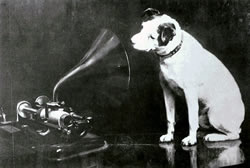catching spirits
oct 29, 2003.
This saturday in Paris brought us a sunny autumn day, and I decided to take the kids to the
Parc Floral where we
could have a picknick, where they could play, and I could do some reading. More or less undisturbed. For, like many, I have these
piles of books en cours de lecture - on my desk, near my bed, in the living room - all but urging me to
take and devour them.
It's not that easy to oblige.
Hesitated between Derrida's Papier Machine (i enjoy trying to read Derrida as if i were listening; his writing is very sonic) and Noise, Water, Meat, Douglas Kahn's 'history of sound in the arts'.
I tossed a coin and took Kahn, and then continued my reading at about page 214, where he writes about Thomas Alva Edison's curious theory of "life units" and the inventor's attempts to construct a device sensitive enough to record these at the instant they leave a dying body. Edison's 'spirit catcher', to him and many others, seemed a fairly logical follow-up to the 'voice writer', that already managed to capture the voices of the living. When William James, one of his collaborators on the project, died, Edison was fairly confident that the man would soon enough find his way back to the 'catcher'. "[James] knew exactly what I am after in this work," he wrote.
 |
At this time and age, (only!) some one hundred and twenty five years after Edison filed the patent for his 'phonograph'
(in 1877), and a mere century after the listening to pre-recorded sound and (surtout) music gradually started
to take the place in everyday life that it has not ceased to occupy ever since, it is pretty hard to imagine the
impact of hearing for the first time something that - vaguely - resembled (interesting how the shock of the novelty at the time rendered any
question as to the 'fidelity' of the sound re-produced a non-issue) a human voice - but is separated from a living body, and coming out of
a machine.
Magical, when compared to the telephone, where there still is, bridging what might
be an ocean's width's distance between, the co-ïncidence of some speaker speaking with the voice that we hear.
Yes, the recorded voice is a voice disem-bodied, cut off from the source, from its causer.
(Note that this separation is the sine qua non of repetition).
For all of known history we were given images from the past.
History did prepare us for photography.
We have only just started a history in sound.
The first ones to lend their ears to a phonograph had not been prepared.
Just as we know through experience that aunt-Bertie-in-the-picture will not age, even though aunt Bertie does (and so does the picture), it is only through experience that we know that Jack Bredford's recorded voice will continue to speak those same sentences through Edison's phonograph or some more recent device, long after Jack Bradford's body and soul have passed on to the other side.
In the 1870's it still might have turned out differently ... One just might have discovered that the
death of a speaker, or the death of a singer, would bring about the disappearance of all recorded instances of their voice.
If nothing else, this would result in pretty interesting record collections. Very dynamic. Very much alive.
(Very empty in the end).
[OK, all this of course is pure speculation so let us for the moment not complicate things by wondering what, in a such possible world, would happen to
the recorded instrumental sounds when the instrumentalist dies; a complete and coherent fiction along these lines obviously
should provide an answer to this question.]
Then I imagined a recording of a composition for choir, say, that would reflect the changes in vocal performance according to that of the singers in an actual 'live' situation. And how in the course of time voices would start to disappear from the recording ...
Maybe even more fascinating: imagine a huge crowd shouting and yelling. In a stadium, or in the street. Age-record it, and hear it change over the years, until eventually it will all have disappeared.
This apparently is not the case in our world (it is not part of our logic). Our sound and image recordings do
not age (it is
only their support that wears off).
But what if we created soundpieces that develop over time, whose 'actuality' will depend on their age?
(Or whatever - among existing (pretty crude) examples one might count compositions whose 'actuality' depends on a
number of randomly chosen parameter values.)
This adds a second time dimension to music.
Of course it is possible to program applications to that effect.
Add history as a dimension to a piece. Make it irreversible.
These would not be recordings in the ordinary sense of the wor[l]d, of course.
They would rather be like an abstraction, a generalization, an encapsulation of the notions of 'bands', 'orchestras',
'ensembles', 'singers' ...
Of performers.
The evolution in time might be something completely different from a simulation of the 'physical aging' of the players. Anything goes.
Any unfolding. It might even be extremely slow. (Like our present day recordings: they have zero-unfolding.)
These are the sort of 'recordings' I was thinking of on saturday.
They will probably not be of much help in catching spirits either.
But in the end it might just help us to catch somewhat up with them.
[ The picture shows the original first version of the painting by Francis Barraud, called 'Dog looking at and listening to a phonograph', that, renamed 'His Master's Voice' and with a gramophone replacing the phonograph, became the classic gramophone record label logo. ]